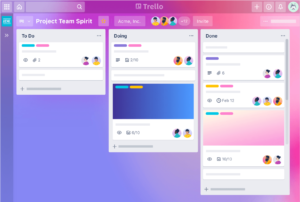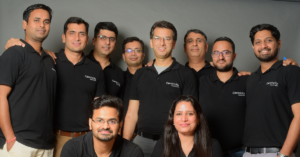Wiebe Konter, CEO and Sander van den Broek, CTO of Optiply | Image credit: Techleap.nl
“The supply chain stuff is really tricky” – Elon Musk
Global supply chain was showing signs of weakness even before the pandemic began but the pandemic exacerbated the issue. While global tech giants like NVIDIA, Apple and Tesla publicly acknowledged the supply chain constraints affecting their business, there were also the small and medium enterprises who were caught up in this supply chain kerfuffle, often without a means to find alternatives.
These are the women in science of the Amsterdam startup ecosystem.
Optiply, a privately held Dutch scaleup based out of Amsterdam with offices in Eindhoven and Evora, Portugal, wants to tackle this supply chain issue that even Tesla CEO Elon Musk finds tricky. The startup plans to tackle the problem with its specialised forecasting and supply management software for webshops, wholesalers and online commerce brands. The scaleup, started by Sander van den Broek and Wiebe Konter in 2015, was part of batch #6 of Techleap’s last Rise programme for 2021 and its journey could lead to a sustainable supply chain model.
A front-row seat to supply chain constraints
You find a solution to a problem only when you experience it for yourself. For Wiebe and Sander, their initial journey is what led them to start Optiply after constantly running into problems with supply. Before starting Optiply, they both owned a webshop offering smartphone accessories. Wiebe says they imported these accessories from China and found it difficult to identify “what, when and where” to order aspects of the supply chain.
At Eindhoven University of Technology, Wiebe Konter mastered replenishment models while Sander Van specialised in data science. This first-hand experience of identifying what goods to order, when to order and from where to order and their expertise learning led them to get the ball rolling on Optiply.
Armed with an idea and means to make it work, the co-founders of Optiply then set about finding out whether other webshops also face similar constraints with their supply chain. Interestingly, they cold emailed some 500 contacts associated with webshops and to their own surprise, they got a number of responses that matched their own experience.
Wiebe admits that solutions to these problems existed but were mainly restricted to management and consultancy and were not market fit for webshops of their size. They quickly sold their webshop, started consulting around the area of supply chain and towards the end of 2016 onboarded their first customer. As a bootstrapped company, Wiebe and Sander focussed extensively on optimising their techniques of supply management.
They were focused to such an extent that Wiebe ran the sales shop even though he is not a salesperson. They also onboarded three developers from Lisbon, Portugal to build their product suite. Within a few years, Optiply became a product fit to tackle the supply side problem faced by SMEs and had grown to between 40 and 50 customers. This allowed Optiply to scale its commercial operation and Wiebe says Optiply now has about 400 customers.
While most of its customers are in the Netherlands, the scaleup has also onboarded customers in the UK and Germany. A team of 40 people, around 25 in the Netherlands and 15 in Portugal, are now looking to solve the problem that has affected businesses of all sizes.
Fast changing consumer demands
Wiebe says everyone was in shock for a moment when the pandemic hit and when the Netherlands went into lockdown, most businesses stopped for a couple of weeks. This is when Optiply published a blog post highlighting the possibility of logistics running while stores close their doors. They also asked their customers to buy and stock up on their inventory when they have the opportunity. Some webshops decided to put all of their money into inventory knowing well that demand will change fast.
During the pandemic and for the past one and a half years, Optiply has used its clever forecasting model to highlight the fast-changing consumer demands. Wiebe explains how the stickiness of consumers have evolved and people switch products and services sooner than they did earlier. While consumer demand kept changing, the supply chain never improved to match that demand.
This made it particularly challenging for webshops to cope with both the variable – a fast-changing consumer demand and a supply chain not catching up.
In the face of this challenge, Optiply helped its customers to become more resilient. It does so with its software that deploys algorithms to automate data-driven choices in the supply chain. The upsell for customers is the ability to use Optiply even without any prior knowledge or understanding of supply chain management.
The data-driven forecasting model from Optiply relies on over 40 forecasting models and AI to help webshops understand what to buy, how much and where to buy. Wiebe explains this by citing an example of a computer accessory and sourcing this product from China, Turkey and also locally from the Netherlands. He acknowledges that margins will be lower when sourcing from places other than China but this also “helps webshops to supply the exact product.”
He also highlights how webshops tapped wholesalers and fellow webshop owners during the pandemic to stay afloat. Wiebe says businesses don’t want to stay stuck with their inventory and during the pandemic, they managed to replenish their stock and keep sales ticking with a collaborative approach. This is a classic example of natural instinct beating software or software learning from our natural instincts.
Supply chain disruption will persist
“It’s definitely going to be a couple of years,” Wiebe says before adding that the reason being that supply chain is always global. He also uses the bullwhip effect, a distribution channel phenomenon where demand forecasts yield supply chain inefficiencies, to explain the disruption.
He says there is extremely high demand for some products right now and wholesalers are ordering more of those products. This results in scaled-up production for that particular product, leading to overflow in the market. He gives examples of home office equipment to drive home this point where consumers are now seeing high pricing for wood and steel.
Rise is peer-to-peer excellence
Wiebe says he “really loved the rise programme” since it is peer to peer. He appreciates the fact that they get to interact with growth mentors or scale icons who have an inspiring story to share. However, Wiebe is quick to point out that their journey is not concrete since they went through the same phase as Optiply probably 10 years ago or longer.
He says drawing inspiration from these scale icons is much easier than drawing parallels with their startups. But for Wiebe and countless other entrepreneurs, these scale icons offer an experience that is easy to relate to and learn from as they continue their journey building a startup aiming for leadership in their domain.
When asked about what attracted him to join Rise, Wiebe says the fact that all the nine scaleups from batch #6 were in nearly identical phases in their growth journey. While some might be ahead in marketing or on the development side, they are all in a phase where they can constantly help each other. “The pairs offer really concrete advice you can use tomorrow,” Wiebe says.
“You come back with like 10 or 20 possible solutions for problems you were actually facing in the past six months, and you’re trying to implement them in the next six months. I could name a few solutions that we’re using already from the learnings,” Wiebe adds about his experience in the Rise programme.
This peer to peer experience, Wiebe says, also helped him fine-tune their mission. He says that Optiply’s vision is to build a “global, autonomous and sustainable supply chain” for webshops. He says the programme has helped the leadership team to understand that they are solving a “global problem”.
Focus on the leadership team
While the challenges are there, Wiebe says Optiply is focussing on building its leadership team and opening in new countries. As a bootstrapped company, Optiply does not plan to raise any funds but is looking to build a dedicated sales, customer success and marketing team for the UK, Nordics and Germany. Wiebe says they want to learn from the experience of opening in these markets before scaling globally.
Optiply does plan to raise funds eventually but that phase will come once they expand to at least 20 European markets and are prepared to set up shop in the United States. With the leadership team in place, Optiply will also focus on scaling its application. Wiebe says they always sell Optiply as a full stack application with a couple of add on features. However, they have realised that customers don’t use all of the features offered by its analytical platform.
They offer container functionality which allows customers to optimise a container in terms of volume and weight. The focus for the leadership team will be optimise these functionalities and build the service for operations that might rely on air or ship or train for their deliveries.
Wiebe also says that Optiply plans to grow from about 40 employees currently to anywhere between 80 and 100 people by the end of this year. He is focused on filling the position of head of sales, a role that will help Optiply scale internationally. They also want to fill multiple roles across customer success and hire dedicated teams for different countries.
How partnering up with Salesforce helped him succeed!



![Read more about the article [YS Exclusive] Anand Chandrasekaran, 9unicorns, Inventus lead $3.5M round in AR social networking app Flam](https://blog.digitalsevaa.com/wp-content/uploads/2021/07/Homingoes-1627423641553-300x150.jpg)





